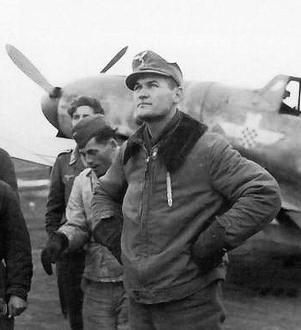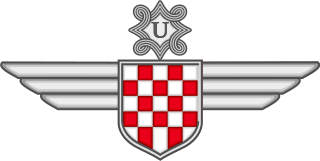
The Independent State of Croatia was a World War II–era puppet state of Nazi Germany and Fascist Italy. It was established in parts of occupied Yugoslavia on 10 April 1941, after the invasion by the Axis powers. Its territory consisted mostly of modern-day Croatia and Bosnia and Herzegovina, as well as some parts of modern-day Serbia and Slovenia, but also excluded many Croat-populated areas in Dalmatia, Istria, and Međimurje regions.

The 8.8 cm Flak 18/36/37/41 is a German 88 mm anti-aircraft and anti-tank artillery gun, developed in the 1930s. It was widely used by Germany throughout World War II and is one of the most recognized German weapons of the conflict. The gun was universally known as the Acht-acht ("eight-eight") by the Germans and the "eighty-eight" by the Allies. Due to its lethality, especially as a tank killer, the eighty-eight was greatly feared by Allied soldiers.

The Flakpanzer IV Kugelblitz was a German self-propelled anti-aircraft gun developed during World War II. By the end of the war, only a pilot production of five units had been completed. Unlike earlier self-propelled anti-aircraft guns, it had a fully enclosed, rotating turret.

Between 1933 and 1945, the organization of the Luftwaffe underwent several changes. Originally, the German military high command, for their air warfare forces, decided to use an organizational structure similar to the army and navy, treating the aviation branch as a strategic weapon of war. Later on, during the period of rapid rearmament, the Luftwaffe was organized more in a geographical fashion.

The Croatian Home Guard was the land army part of the armed forces of the Independent State of Croatia which existed during World War II.

World War II in the Kingdom of Yugoslavia began on 6 April 1941, when the country was invaded and swiftly conquered by Axis forces and partitioned among Germany, Italy, Hungary, Bulgaria and their client regimes. Shortly after Germany attacked the USSR on 22 June 1941, the communist-led republican Yugoslav Partisans, on orders from Moscow, launched a guerrilla liberation war fighting against the Axis forces and their locally established puppet regimes, including the Axis-allied Independent State of Croatia (NDH) and the Government of National Salvation in the German-occupied territory of Serbia. This was dubbed the National Liberation War and Socialist Revolution in post-war Yugoslav communist historiography. Simultaneously, a multi-side civil war was waged between the Yugoslav communist Partisans, the Serbian royalist Chetniks, the Axis-allied Croatian Ustaše and Home Guard, Serbian Volunteer Corps and State Guard, Slovene Home Guard, as well as Nazi-allied Russian Protective Corps troops.

The Air Force of the Independent State of Croatia, was the air force of the Independent State of Croatia (NDH), a puppet state established with the support of the Axis Powers on the territory of the Kingdom of Yugoslavia during World War II. The ZNDH was founded under German authority in April 1941, following the German-led Axis invasion of Yugoslavia.

The Navy of the Independent State of Croatia, was the navy of the Independent State of Croatia, an Axis puppet state controlled by the fascist Ustaše party. The NDH was created from parts of the Kingdom of Yugoslavia on 10 April 1941, four days after the World War II invasion of Yugoslavia by the Axis powers commenced. The RMNDH consisted of two commands, the Coast and Maritime Traffic Command, and the River and River Traffic Command, and had its headquarters in the NDH capital, Zagreb. The Coast and Maritime Traffic Command consisted of three naval commands along the Adriatic coast, which were each divided into a number of naval districts. The naval districts consisted mainly of naval and weather stations, and were only responsible for coast guard and customs duties. The River and River Traffic Command consisted of seven river stations, a naval infantry battalion, and a River Command Flotilla built around two former Yugoslav river monitors, which had been scuttled during the invasion but subsequently refloated.

Mato Dukovac was the leading Croatian fighter ace of World War II, credited with between 40 and 44 confirmed victories. He joined the Air Force of the Independent State of Croatia following the Axis invasion of Yugoslavia in April 1941, and then the Luftwaffe, with which he flew combat missions on the Eastern Front. His tours of the Eastern Front spanned October and November 1942, February to June 1943, and October 1943 to March 1944. He defected to the Soviet Union on 20 September 1944 and was returned to Yugoslavia in November 1944. He worked as a flight instructor for the Yugoslav Air Force in Pančevo and Zadar before defecting to Italy in April 1945.

The 369th (Croatian) Reinforced Infantry Regiment was a regiment of the German Army raised to fight on the Eastern Front during World War II. The regiment was formed in July 1941 by Croatian volunteers from the Independent State of Croatia (NDH), including a Bosnian Muslim battalion. It was commonly referred to as the Croatian Legion. The troops swore a joint oath of allegiance to the Führer, the Poglavnik, the German Reich and the NDH. The unit was sent to the Russian front, where it was attached to the 100th Jäger Division. It was the only non-German unit to participate in the battle of Stalingrad as part of the 6th Army, where it was destroyed. On 31 January 1943, the 800 surviving Croatian legionaries, led by their commander Marko Mesić, surrendered to the Soviet Red Army.

The Croatian Air Force Legion, or HZL, was a unit of the Luftwaffe, composed entirely of volunteers drawn from the nazi puppet-state, the Independent State of Croatia. Many of them had previously served in the Royal Yugoslav Air Force in April 1941 during the Nazi Invasion of Yugoslavia.

The Croatian Naval Legion was a contingent of volunteers from the Independent State of Croatia that served with Nazi Germany's navy Kriegsmarine, on the Black Sea and Adriatic Sea during World War II.

The 392nd (Croatian) Infantry Division was a so-called "legionnaire" division of the German Army during World War II. It was formed in August 1943 using Croatian Home Guard soldiers with a German cadre. The division was commanded by Germans down to battalion and even company level in nearly all cases. Originally formed with the intention of service on the Eastern Front, this did not eventuate, and the division was used in anti-Partisan operations in the territory of the Independent State of Croatia (NDH) until the end of the war. It was commonly known as the Blue Division.
The Messerschmitt Bf 109 is a German World War II fighter aircraft designed by Willy Messerschmitt and Robert Lusser during the early to mid-1930s. It was one of the first true modern fighters of the era, including such features as all-metal monocoque construction, a closed canopy, a retractable landing gear, and was powered by a liquid-cooled, inverted-V12 aero engine.
Air warfare during World War II in Yugoslavia pitted the Yugoslav Air Force, both Royal and NOVJ, United States Army Air Force (USAAF), the Royal Air Force (RAF), including the Balkan Air Force, and Soviet Air Forces against the German Luftwaffe, the Italian Regia Aeronautica and the Air Force of the Independent State of Croatia. The latter provided the majority of the support for the ground operations against the Partisans. The Allied forces engaged in an extensive bombing campaign in an effort to weaken the Axis hold on the country.
This article details the history of the Croatian Air Force. The Republic of Croatia is a unitary democratic parliamentary republic in Europe at the crossroads of Central Europe, the Mediterranean, and the Southeast Europe. Its capital and largest city is Zagreb. The modern Croatian Air Force was established on 12 December 1991, during the Croatian War of Independence.

The 369th (Croatian) Infantry Division was a legionary division of the German Army (Wehrmacht) during World War II.

The 373rd (Croatian) Infantry Division was a division of the German Army during World War II. It was formed in June 1943 using a brigade from the Home Guard of the Independent State of Croatia with the addition of a German cadre. The division was commanded by Germans down to battalion and even company level in nearly all cases, and was commonly referred to as a "legionnaire division". Originally formed with the intention of service on the Eastern Front, it was used instead for anti-Partisan operations in the territory of the NDH until the end of the war. It fought mainly in the western areas of the NDH, and was involved in the attempt to kill or capture the leader of the Partisans, Josip Broz Tito, in May 1944. Severely depleted by desertion, the division withdrew towards the Reich border in the early months of 1945, eventually surrendering to the Partisans on 10 May 1945 near Brežice in modern-day Slovenia.
The Ustaše Militia was the military branch of the Ustaše, established by the fascist and genocidal regime of Ante Pavelić in the Independent State of Croatia (NDH), an Axis puppet state established from a large part of occupied Yugoslavia during World War II.














